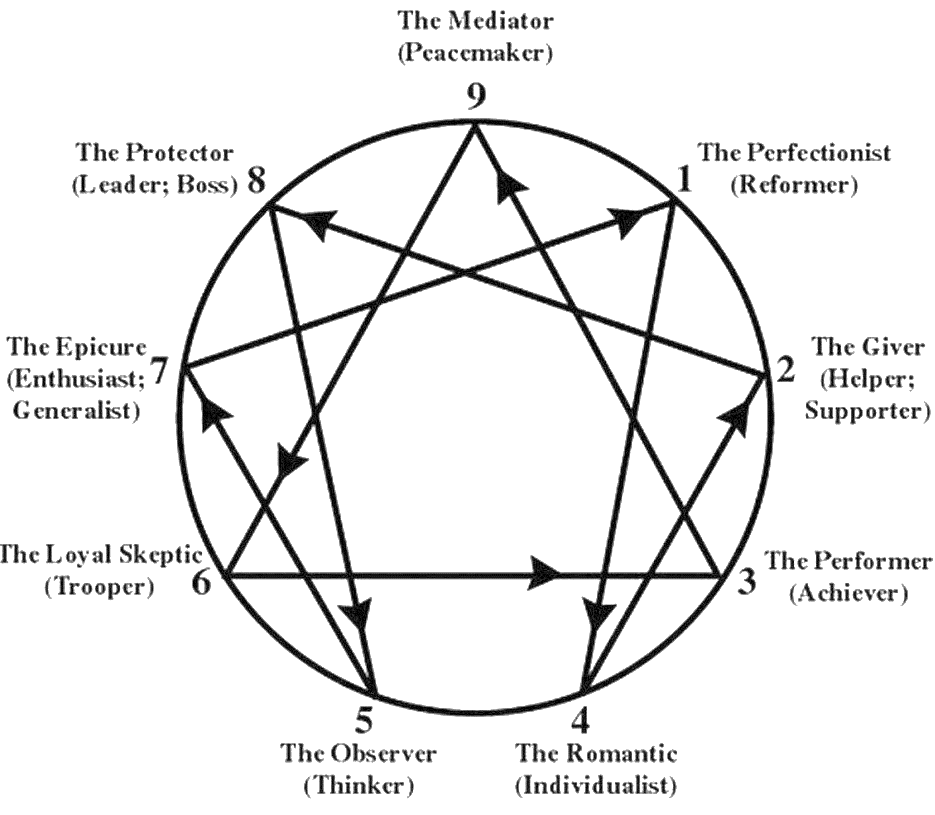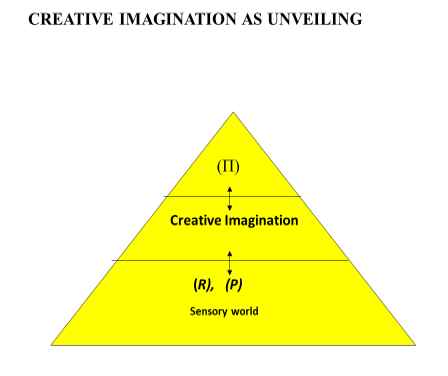The enneagram strategy is a structural typology that many organisations and individuals use to effectively understand their business profiles and interpersonal patterns, despite scholars showing concerns about its robustness and dynamism.
- enneagram
- creativity
- meta-model
- networks
- systems
- grammar
- organisation
1. Introduction
This is the first publication of the Enneagram of Strategy in a Western Journal. The Enneagram originated in Sufism. It is a mystical symbol (Mandala), adapted to personality typology by psychologists. Alongside Jungian/Myers Briggs, it is widely used in human resource management. The authors apply the Enneagram to strategic decision-making and use it in executive programmes and consulting.
The strategy process in an organisation is represented in the diagram through the directed hexagram, 142857, a repeated sequence since decision-making is a continuous process. The state of an organisation at a particular time is described by the triad 936. The hexagram plus the triad makes up the nine-point Strategic Enneagram below. Both state and process take place within grammar. Grammar (Organization Grammar) corresponds approximately to the rules governing computer programmes that John Holland (2018) described as standard operating procedures (SOPs). But our concept of grammar is richer and closer to what analysts describe as culture, but richer than culture in recognising the formal and informal conscious and unconscious rules underlying human interactions.
We outline the meaning of the symbolism in our paper in the next section. The methodology provides a strategic framework, but most importantly, the Strategic Enneagram is a Mandala designed to evoke management creativity.
The application of the Enneagram as a typological tool for human resource managers is not our concern here. Hook et al. (2020) review empirical work on the Enneagram typology for clinicians. Their review reveals consistency with such constructs as the Big 5 and points to several studies suggesting that Enneagram was helpful for personal and spiritual growth. Although personality typing is not our principal concern, we hope that the reader may gather that there are clear parallels between our work in business strategy and creative thinking, especially with respect to the imaginative and creative aspects of the Strategic and Enneagram of Personality and the possible synchronous relation between them. The link between strategic decision-making and creativity is the particular concern of this note.
Figure 1: The diagram below illustrates the Strategic Enneagram.

2. Deconstructing the Strategic Enneagram
The Enneagram has a long history. Prior to its adoption by Sufis, the 9-figure Ennead appeared in Ancient Egypt and in the six Enneads of Plotinus. Figure 1 shows the nine-point Enneagram consisting of an inner triangle describing the state of an organisation at a particular time S(t) represented by 3, 6, and 9, numbers that divide the 9-point enneagram into three parts by the triangle 9, 3, 6 (respectively 2pi, 1/3pi and 2/3pi). The strategic process is represented by the twisted hexagram that divides the 9-point enneagram into 6 parts, represented by the repeated sequence 142857142857. The repeated sequence of six numbers represent the repeated sequences 1/7 = 0.1438571428571….; 2/7 = 0.285714…...; 3/7 = 0.428571 428…...; 4/7 = 0.571428571…; 5/7 = 0.712485714…...[6/7 = 0.857142857……
The Strategic Enneagram is symmetric. The strategic process is divided into a conceptual phase sequence 1, 4, 2, and action phases 8, 5, 7; a reflective phase 7, 1 posing the question “Is the original vision being implemented”? a control phase 2, 8 asks. Do our actions embody our values? Taken together phases 7, 1 and 2, 8 reflect the continuous adaptation and revision necessary to any decision process as circumstances (inner and outer dynamics and desired payoffs) change. The Strategic Enneagram is symmetric around risk since risk emerges when cognition (vision, feelings/values and imagining alternatives) becomes action (implementation). Everything and anything can be imagined, but is what is imagined feasible? Can it be realised in spacetime?
Grammar determines (a) the nodes (the aspects of the world we choose to focus on) and (b) connections (how the nodes are linked). Nodes correspond to the parts of speech (nouns, verbs, adjectives, prepositions and so on) in ordinary grammar. Linkages correspond to the syntax (grammatical rules) that connects part of speech. It governs actions, permitting some and forbidding others, serving as a standard for judging success or failure, and includes commands, laws and imperatives, explicit and implicit. It can be definite but seem vague, fluctuating, or even contradictory. Grammar is a form of conditioning. It is both an individual and group phenomenon that evolves over time. It includes rules, laws, regulations, cultures, and ways of thinking about problems. Considering grammar in its entirety, it is a set consisting of many interacting sub-grammars; internal/ external, conscious/unconscious, formal/informal, personal/social, and tacit/explicit.
Table 1 explains the categories of the Strategic Enneagram briefly.

3. The Enneagram of Personality
The Enneagram of Personality is widely used in the personal and spiritual growth, personality and psychological development domains (Hook et al., 2020; Riso & Hudson, 1999). It describes nine distinct personality types, each with its own traits, motivations, and behaviours. Practitioners see it as a powerful tool for self-discovery. We focus on its heritage which we take to be an offshoot of Jungian typology and on Jung’s concept of synchronicity. Jung divides personality functions into rational functions, thinking and feeling and irrational functions instinct and intuition, the latter, intuition, being associated with wisdom. The second concept, synchronicity, Jung defines as an “acausal connecting principle”; acausal in that it corresponds to correlations between phenomena rather than causal relationships. Clinicians are more sceptical about the efficacy of the Enneagram of personality as a psychological tool. However, perhaps their scepticism can be alleviated by its synchronous aspects which link to our notion of Grammar. Synchronicity appears to be foreign to academic research, but we claim, foreign in appearance only. The eminent statistician Karl Pearson, for example, emphasised correlation over causality. The Enneagram of Personality can be interpreted as an alternative Grammar, as an alternative set of categories or types that alleviate the entrapment of conventional ways of looking at things and open up the imagination to see situations and different perspectives; that is, to exercise Creative Imagination.
The Enneagram of Personality is illustrated in Figure 3 below, which is based on, Navabifar et al., 2020; Dooley and Ven (1999). We claim that a synchronous relationship exists between the two Figures 1 and 3.
Enneagram typologists assert that each type has traits that individuals, teams, groups, and entire societies can make more effective decisions and perhaps live more happily. They assert that leaders who understand the Enneagram of Personality and their leadership and management skills; can foster self-awareness and result in the outcomes envisaged by Mindfulness.

Figure 3
4. Creative Imagination
We only give a brief outline of Creative imagination. Creative Imagination has its heritage in Islamic philosophy, and it is related to Jung’s concept of Active Imagination. We follow the approach of Ibn Arabi, a Sufi mystic, scholar, and philosopher since it enables the concept of Creative imagination to be expressed in familiar terms.
The American Psychological Association (APA) describe Creative Imagination as the “faculty by which new, uncommon ideas emerge, especially when emergence does not seem explicable by the mere combination of existing ideas. The operations of the creative imagination are sometimes explained by the interaction of dormant or nonconscious elements with active, conscious thoughts”. The APA definition is close to Ibn Arabi’s; there is an underlying reality hidden beyond the reach of Grammar of any kind since Grammar creates a veil between what is perceived in what we call the Real World and what is. Thus, creative imagination is a matter of successive unveiling of the underlying Reality. Ibn Arabi’s and APA’s definitions are close rather than identical, but their closeness enables Creative Imagination to be expressed in familiar terms. See Figure 4 below and the last column of Table 1.

In Figure 4 (R) and (P) refer respectively to the So-Called Real World that is available to the senses to what is realised (R) and what is possible given the prevailing Grammar. Advances in science and the arts advance progressively as Grammar evolves. New possibilities, interrupted by lapses and retreats, emerge. The relation between (R) and (P) is probabilistic rather than deterministic. Creative Imagination involves shedding existing Grammar, shedding preconceptions that acted as a Veil and seeing what was previously inconceivable, which we designate as in other words, Unveiling the Underlying Reality.
5. Concluding Remarks: The Strategic Enneagram as a Mandala
The Strategic Enneagram has been developed by scholars and researchers over the last twenty years or so. Viewed as a Mandala or symbol for contemplation it bridges on the one hand rational, logical or algorithmic approaches and on the other, intuitive and creative approaches to decision making.
It is emphasised that what we describe as a science of imagination is a science: in the sense that it is empirical and verifiable by direct experience: its experiments can be described precisely and are repeatable (see for example Mehdi 1992; James, 1936). Normally science is seen as obtaining knowledge by correspondence; we know something because it corresponds to something else. The observer and the observed are treated as separate. Sciences of the imagination are concerned with knowledge by direct perception: that is with knowledge by presence, meaning that there is no separation between the observer and the observed: knowledge by presence implies that they are acknowledged as part of the same unity.
We distinguish at least three accessible worlds in Table 1; the world of time and space (R), and the potential world (P), the world of possibilities, both of which are known, the former by experience, the latter by learning from experience. The (P). These three (levels or planes of being) are subsets of an all-encompassing space, W. We can think of W as an imaginary gallery that contains everything, an infinite gallery. By far the largest part of the gallery is unexplored but is there to be discovered. At a particular time we occupy a space (R), which corresponds to Heidegger’s concept of Dasein (which consists of what is to hand) and consciousness which corresponds to his notion of authenticity. The material world (R) can be grasped by the senses: it is the world of space and time.
Shedding pre-conceptions moulded by Grammar that acted as a Veil and seeing what was previously inconceivable, we designate as (ΙΙ). The Underlying Reality.
|
Domains of Being |
|||
|
(R) |
Time and space |
Material or sensory world |
Realised/implemented |
|
(P) |
Potential |
Feasible/possible world |
Within existing knowledge |
|
(P). |
Imaginal |
Archetypal world |
Undiscovered |
|
Ω |
Unity |
Source |
Contains all possible worlds |
Ω is beyond an entire series, perhaps the infinite series of Veils. Sciences of the imagination, or contemplative sciences include Taoism, Zen, Sufism and Buddhism and have a long history, but they have become neglected in mainstream modern thinking. The Strategic Enneagram Mandala blends the mainstream and the contemplative. Applied to ordinary life, ( R) for example to business and management we claim it offers up a transition, not only in nations, organisations and economies, but also the transformation of individuals trapped, in modern society between, on the one hand, striving, and on the other hand, a sense of emptiness. As Vaclav Havel expresses it:
“...modern technological civilisation……despite its successes …has lost its potential. Man as an observer is becoming increasingly alienated from himself as a being. The abyss between the rational and the spiritual, the objective and the subjective, the technical and the moral, the universal and the unique constantly grows deeper.”
This entry is adapted from the peer-reviewed paper 10.3390/admsci13050119
